Lovely crisp Scottish shortbread, made with just 4 simple ingredients, including rice flour, for perfect crisp! Simply mix and press into the pan. The unique twice-baked shortbread ensures perfect texture every time.
This Scottish Shortbread recipe was the WINNER of the
Pancake Princess’ Best Shortbread Bake-Off!!
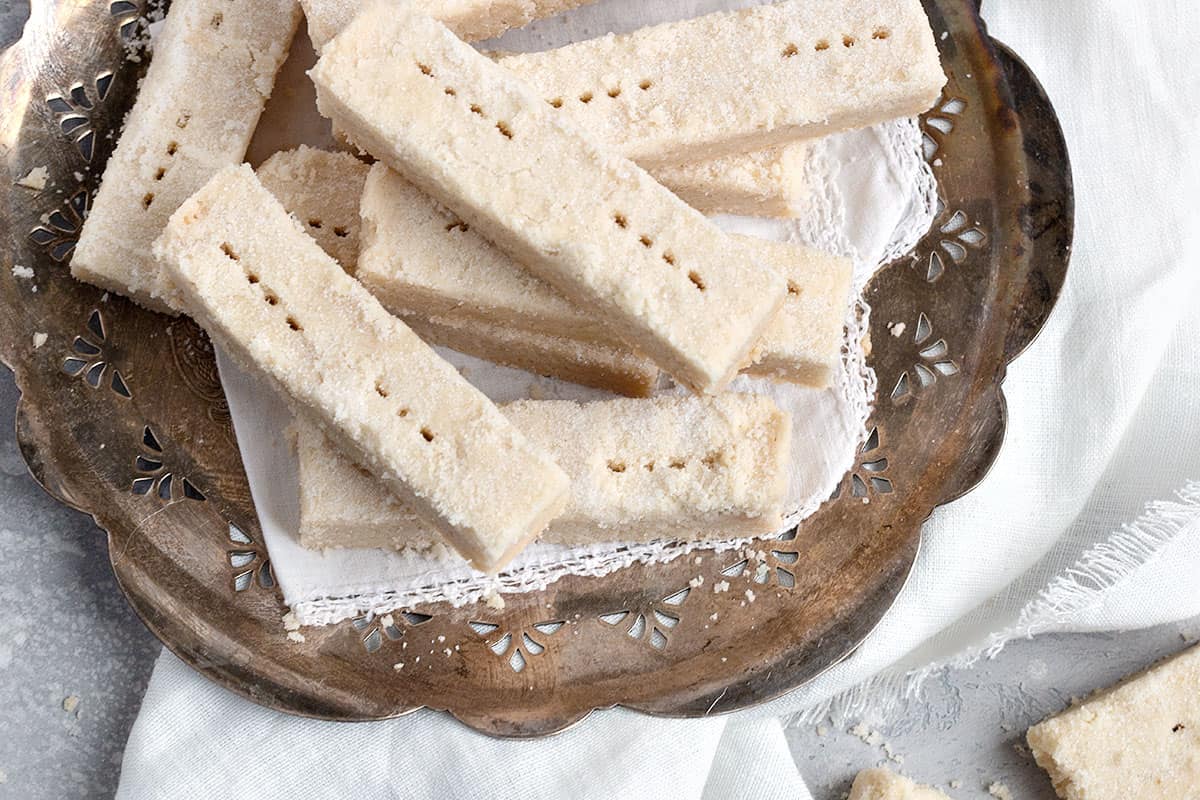
Why you’ll love this Scottish shortbread recipe
- I love this traditional Scottish shortbread recipe with rice flour! The thick cookie sticks, with their sandy texture and touch of crispiness, fall right in the middle on the sweet scale, which is perfect for me.
- This rice flour shortbread uses just 4 simple ingredients – all-purpose flour, rice flour, good butter and sugar. The addition of rice flour is perhaps the biggest game-changer with these shortbread cookies. It produces a texture that’s impossible to achieve with other additions or with simply regular flour.
- Beyond the simple ingredients, I use a unique twice-cooked cooking method that ensures a lovely tender-crisp finished texture.
- These cookies can be enjoyed on the day they are baked, but they only get better with each day that passes, so they are perfect for making ahead.
Ingredients and substitutions
Butter – when it comes to shortbread, the better your butter, the better your shortbread! Buy the best butter you can find and if you can get your hands on some higher butterfat butter (such as Gay Lea’s Baker’s Gold (84% b.f. or Kerrygold 82% b.f.), definitely go for it. Alternately, just use the best butter you can find. This is no time for the value brand :)
You can use either salted or unsalted butter here, but my preference is always unsalted butter, as it tends to be the best butter. If using unsalted butter, you can add a pinch of salt to the cookie dough.
Rice Flour – rice flour is relatively easy to find and makes all the difference in these shortbread cookies. I highly recommend seeking it out and using it for these cookies! Look for White Rice Flour from Bob’s Red Mill or Clubhouse, among others or if you are in Canada, you’ll easily find it at Bulk Barn. You don’t want to use any rice flour labelled as “glutinous”, as that is a different product.
If you absolutely can’t find rice flour, you can substitute an equal amount of cornstarch (cornflour), though cornstarch will produce a less crispy cookie.
All-Purpose Flour – I prefer regular bleached all-purpose flour for these cookies, as it produces a lighter- coloured cookie, but unbleached all-purpose flour will work here, as well.
White granulated sugar – this recipe is written for regular, white granulated sugar. If you like to experiment, instead of 1/2 cup regular white sugar, use 1/4 cup superfine white sugar and 1/4 cup regular white sugar. The superfine sugar does lovely things to the finished texture, though I found it a little too sweet when I tried all superfine sugar.
How to make Scottish shortbread
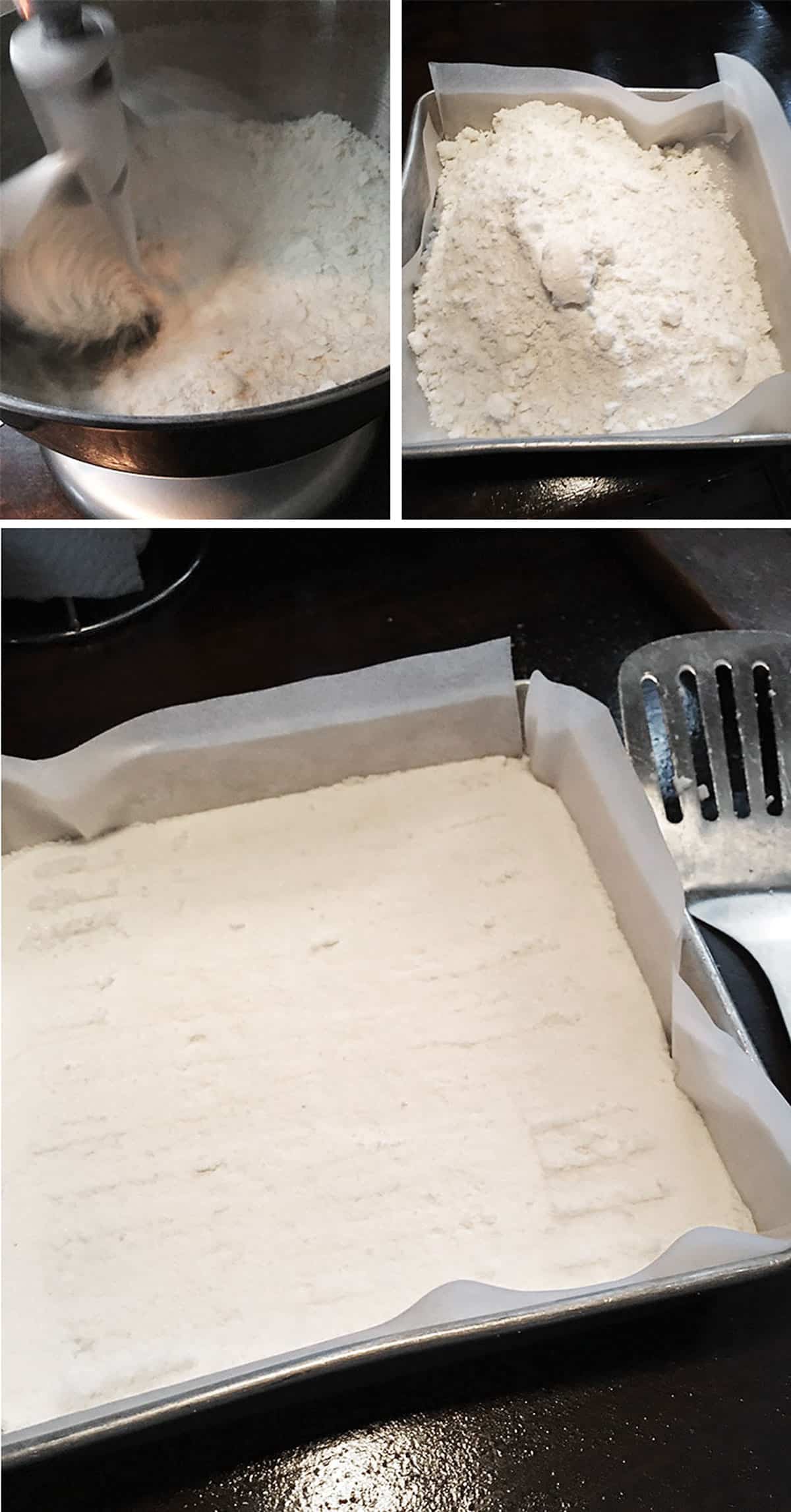
- Don’t expect this dough to really “come together” as you are mixing it. It will and should be sandy, with small, even-sized pieces of butter. If you squeeze a small bit together though, it should clump (you can see a “clump” in the process photo below where it’s dumped into the pan. That is a clump, not a lump of butter on top.)
- After adding to your pan, use your kitchen spatula to press down firmly into the pan. I’ve added some pictures just to assure you that yes, this is what it’s supposed to look like :)
- If by chance your dough has turned out more moist than shown here, it may be due to your butter having more moisture in it. As long as it isn’t too moist (sticky), it will be fine. If your dough is sticky, you have likely not added enough flour (perhaps due to how you measured it). I would suggest adding a bit more flour, as needed, until the dough is no longer sticky.
- Finally, if your dough doesn’t clump at all (it’s too dry), you have probably added too much flour. Again, it’s probably due to how you measured the flour. I always recommend measuring flour using the stir, spoon and level method, for best results. To correct a too-dry mixture, add a bit of water, a teaspoon at a time, until the dough clumps, as shown.
Recipe tips!
- If your butter has a lot of moisture (less expensive butter tends to have more water in it), your dough may be more moist than is shown here. The cookies will still be fine, but with a slightly different texture.
- For the final cooking period (with the oven off), leave in the oven for 30 minutes for crisp, but still light-coloured cookies or 45 minutes for crispier, lightly golden cookies. I personally find about 40 minutes just perfect.
- If you like, you can sprinkle a little white sugar on top of your cookies before the final baking.
- As these cookies have a very fine texture, they are quite fragile and prone to breaking as you work through making them. If you are just making for yourself, no worries if one or two break, but if making these as a gift, consider cutting smaller pieces (1-inch x 2-inch maybe) or even squares, so they will be less likely to break.
- If you find your cookie sticks break in the middle, you can often “repair” them before the final cooking by simply pressing the two pieces together well. They will often mend together during the final bake.
Storage and Freezing
Shortbread cookies only get better with age, so my preference is to simply store them at room temperature in an airtight container, such as a cookie tin. They will keep well for several weeks, so don’t hesitate to make ahead.
While you can freeze these cookies, I always find that cookies tend to pick up some freezer flavours or slightly change in texture. As shortbread keeps so well at room temperature, for a quite long period of time, I would only freeze for much longer storage circumstances.
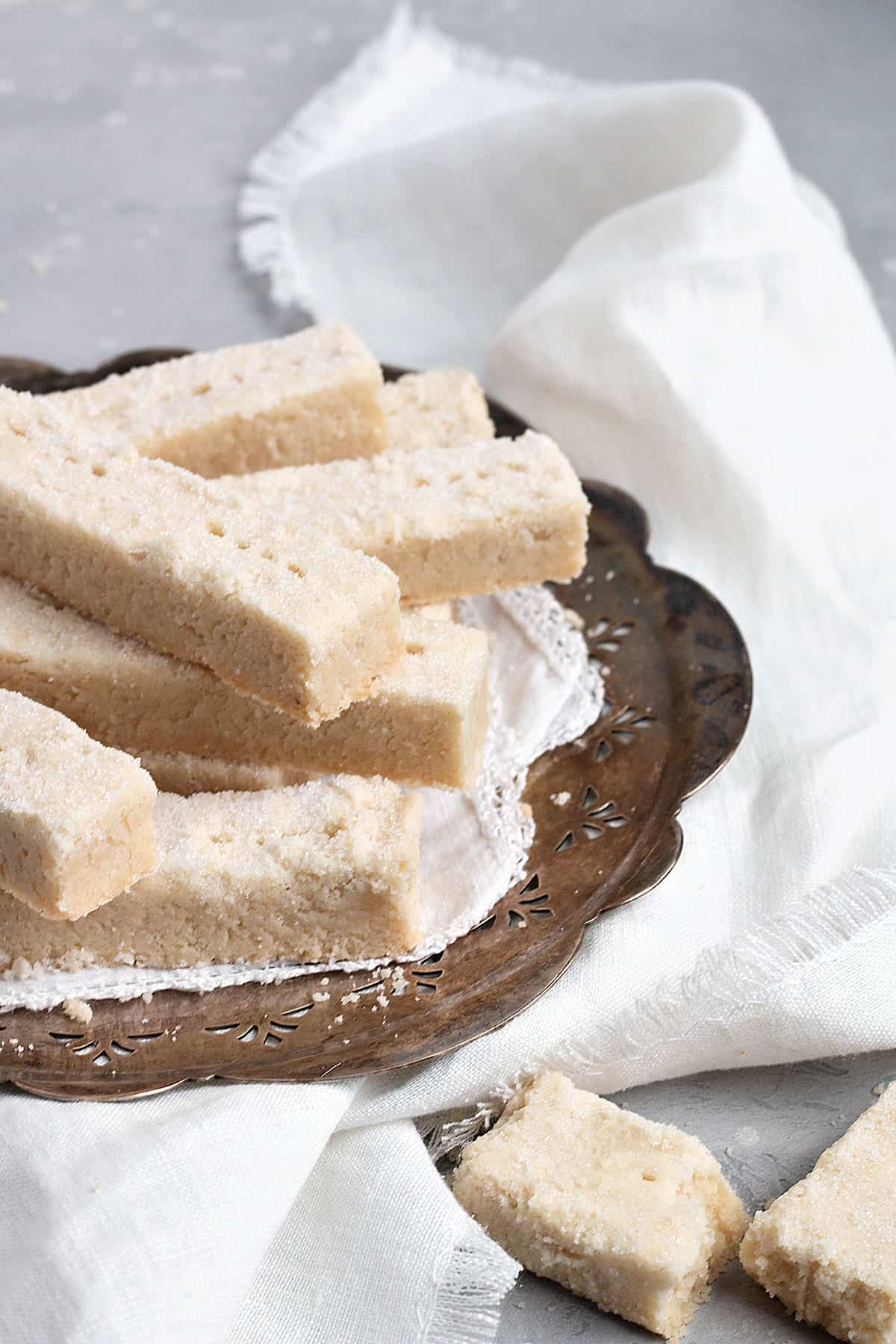
Variations
I’m a bit of a purist when it comes to shortbread cookies, but if you would like to dress up your shortbread, some people like to dip the bottom in melted chocolate.
Scottish shortbread is sometimes made with either all or part brown sugar. I haven’t tried this myself, but if you are the experimenting type, you could try replacing half of the white sugar with brown sugar.
Want to save this recipe?
Enter your email and I’ll send it to your inbox. Plus, you’ll get great new recipes from me every week!
By submitting this form, you consent to receive emails from Seasons and Suppers.
You can unsubscribe at any time.
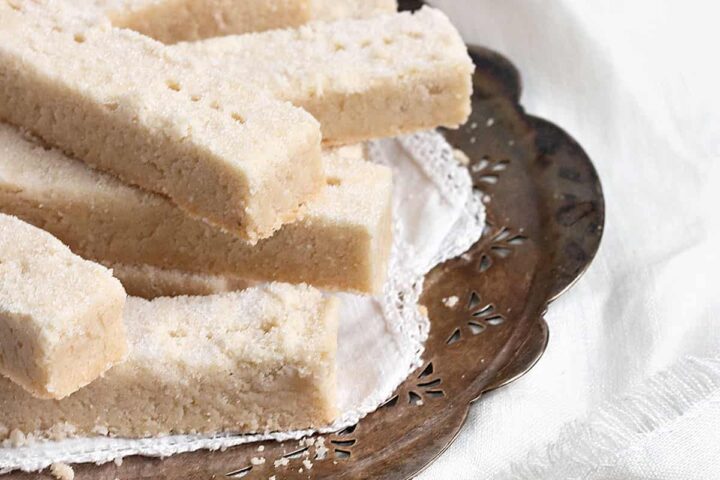
Get the Recipe: Simply Perfect Crispy Scottish Shortbread
Ingredients
- 1 1/2 cups (180 g) all purpose flour, measure with the spoon and level method
- 1/2 cup (77 g) white rice flour, spooned and levelled (not glutinous rice flour)
- 1/2 cup (100 g) white granulated sugar
- 1 cup (227 g) unsalted butter, cold, cut into about 16 pieces **see Note 2 below
- 1/4 teaspoon fine sea salt , omit if using salted butter
Instructions
- Preheat oven to 350F (regular bake/not fan-assisted), with rack in centre of the oven. Line an 8-inch square metal baking pan with parchment paper, leaving an inch or so overhanging the sides to use as handles to remove the cookies later. Set aside.
- In a large bowl with an electric mixer or the bowl of a stand mixer fitted with a paddle attachment, mix together the all-purpose flour, rice flour and sugar. Add the cold butter cubes and mix on low speed for several minutes, until the butter is broken down into small, even-sized pieces. Mixture will usually be loose and sandy, but if you grab a bit of it and squeeze it, it should form a clump. (If your butter had more moisture, the mixture could be more moist. As long as it isn't sticky, it's fine. See Note 2 below to troubleshoot texture).
- Dump mixture into your prepared baking pan. Using a kitchen spatula, press mixture firmly into the pan. (See process photos above this recipe card). Try to get the top as even as you can.
- Bake in preheated oven for about 35 minutes or until set, but not with any browning around the edges at all. (If you dough was more moist, it may need a few more minutes in the oven, maybe 40 minutes). Remove from oven (*Leave oven on!) and let stand for ONLY 10 minutes. Using a sharp knife, cut (slowly and carefully), into 16 pieces (1-inch wide x 4-inches long). Using a fork, press fork twice into each of the "sticks", if you like, making sure to press right through the cookie to the bottom of the pan.
- Grab a baking sheet. Very carefully, using the parchment overhang as handles, lift the cookies out of the pan on the parchment paper. Set onto baking sheet with parchment paper still underneath. Using a fork, gently slide the cookie sticks apart, so there is a bit of space between each piece. *If a cookie stick breaks, you can often press it back together at this point and it will mend itself during the final bit of cooking.
- Return to the 350F oven, BUT IMMEDIATELY TURN THE OVEN OFF! Let sit on the baking sheet in the still-warm oven for 30-45 minutes. (30 minutes for a lightly crisp, light coloured cookie or up to 45 minutes for a crispier, lightly golden cookie). Remove from oven and transfer cookies to a cooling rack to cool completely.
- Once cooled, store in an airtight container at room temperature. Cookies can be eaten right away, but they develop even more flavour as they sit, so don't hesitate to make ahead.
Notes
- Unsalted butter will produce the best results and is recommended. Look for high-fat (84%) butter, European-style butter or something like a Kerrygold. The best butter you can find! Salted butter will work, but omit the added salt in the dough.
- If by chance your dough has turned out more moist than shown here, it may be due to your butter having more moisture in it. As long as it isn’t too moist (sticky), it will be fine. If your dough is sticky, you have likely not added enough flour (perhaps due to how you measured it). I would suggest adding a bit more flour, as needed, until the dough is no longer sticky. Finally, if your dough doesn’t clump at all (it’s too dry), you have probably added too much flour. Again, it’s probably due to how you measured the flour. I always recommend measuring flour using the stir, spoon and level method, for best results. To correct a too dry mixture, add a bit of water, a teaspoon at a time, until the dough clumps, as shown.
More Shortbread Recipes to Love!
Hi! I’m Jennifer, a home cook schooled by trial and error and almost 40 years of getting dinner on the table! I love to share my favourite recipes, both old and new, together with lots of tips and tricks to hopefully help make your home cooking enjoyable, stress free, rewarding and of course, delicious!



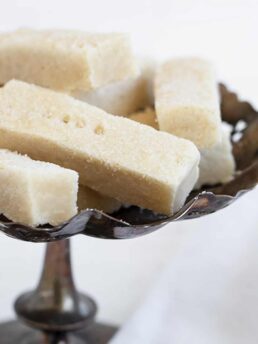
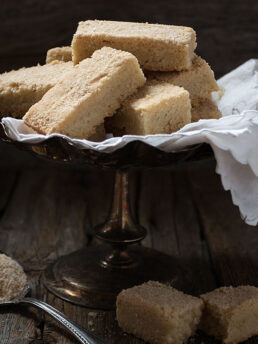


How does the dough and biscuits look so pale? Isn’t shortbread a buttery light yellow colour?
Commercial shortbread seems to be yellowy, but homemade shortbread are always pale in colour in my experience.
Just made them and they turned out a buttery, golden colour. I’m European and used European butter. Maybe that’s why? I only rounded up the flour to 200grams to get what I thought would be the right consistency. Anyway, they are absolutely excellent and so much better than store bought shortbread biscuits. I’m keeping this recipe forever. Thanks!
I didn’t realize European butter was more yellow and yes, that would certainly account for the colour difference. Glad you enjoyed them :) Thanks!
Hi! I was just wondering if I can add some chocolate and how much should I add? Thanks
Hi Elise, I’ve never tried incorporating chocolate into this recipe. It should be fine but as I’ve not tested it, I can’t say for sure. I would just add some chocolate at the end of mixing the dough, adding it a bit at a time until it seems right.
Hello,
This sounds like a wonderful recipe. If I added “lavender tea” to the recipe, how much should I use, and how and when do I incorporate into the recipe? Thank You.
Hi Rose, you should add the tea leaves with the flour so it mixes in with the dry ingredients and then the butter. I don’t have a precise guidance on how much to add, but I think I would only add about 1-2 teaspoons myself.
Any winner of a pancake princess review is top notch ! I cant wait to make these !
Hi Jennifer,
Being a retired pastrcook i have made my share of shortbread.
Your recipe is by far the best shortbread i have tried.
I found Lurpak butter here in Queensland and it worked out fantastic.
I am flat out cooling them as they just vanish and i am now on my 4th batch.
Thanks jennifer your recipe has put a bit of spark into a retired baker and now i make many slices and cakes for the family but your shortbread is a standout.
Cheers.
Merry Christmas and a happy new year to you and your family.
Regards,
Gary.
I’m so glad to hear, Gary :) Thanks so much and Merry Christmas to you, as well!
Am going to try this recipe on Monday and compare it to my mum’s recipe. I’ll have my co-workers rate it. I am having trouble finding the method of making. What am I missing?
Hi Aileen, you need to scroll down to the bottom Recipe Card where you’ll find the complete ingredients list and instructions.
Made these last week and they are just fabulous. I followed the recipe just as written. My kids adore them’
Thanks so much.
One question; can I freeze the dough?
So glad to hear, Alice! As for freezing the dough, I haven’t done it myself. That said, cookie dough tends to freeze well, so I think it’s worth a try!
I would like to add dried cranberries. Would the recipe still work?
Thanks.
Hi Teresa and yes, it would. I would cut the dried cranberries quite fine or you will find it difficult to cut the cookies.
thanks for a wonderful recipe, i’ve had great results!
I made a few adjustments, as running it as is (in Australia) turned out tasty but well browned biscuits:
1) 170’C temp in my (overly efficient) fan-forced oven
2) reduced time to 26 minutes (+ the usual 30 minutes in the cooling oven)
3) best butter i could find was 82.8% (westgold)
4) it was slightly too easy to clump, so rather than adding flour (and changing the flavour), i rounded the rice flour to 80g, and mixed it less.
Thanks Rowy. Great tips and so glad you’re enjoying them :)
I discovered Bakers Gold several years ago when I first started making this recipe. It’s a fantastic recipe! So glad I stumbled upon it. I have been making this recipe since 2019 and it is a more refined recipe of a Scottish recipe that has been handed down in my husbands family. Especially helpful when you don’t have anyone in the family to show you how to make it!!!!! Thank you!
So glad you are enjoying these cookies, Karen! Thanks so much :)
Okay, I had a problem. Have to figure this out. My ‘very sharp knife’ cut through some of the parchment under the cookies, and therefore it wasn’t a stable sling to lift the cookies out. It was buckling terribly every time i tried. This batch went into the oven for the second bake (oven off), still in the pan. And they’ll have to cool in the pan too I’m afraid. I will make another batch, and I’m sure these will taste great; but not quite as intended. Any suggestions?
Hi Margo, if you can coax one out of the pan, you can use a spatula to slide under them and lift them from the pan.
Thank you! I have a flexible / expandable rectangular pan which I’ll use next batch. It’s like a springform ring, only rectangular and adjustable. That way i can just remove it and it should work great. The first batch taste phenomenal. I’m Scottish in origin and have made soooo much shortbread over the years. This is an amazing easy recipe to put together. Might just become my go-to.
Hi! These look like they will be delicious, and I can’t wait to try them! I am thinking of adding in chai spices and some vanilla, but don’t know if the ratios would change? Have you tried adding any dry ingredients to this recipe? And if so, what ratios?
Thanks!
Hi Alicia, it would depend mostly on the amount you are adding. Dried chai spices would probably not be an issue. Liquid vanilla is more of an issue as that will possibly affect the dough to some degree. You could use vanilla-infused sugar as an option, which wouldn’t affect the ratio if it replaces the regular sugar in the same quantity. Generally, dried add-ins in moderate quantities won’t be an issue.
I bake Scottish shortbread quite often! I ‘m from Scotland and I live overseas, and miss the taste of home , so the baking trays come out often, and I make Madeira cake, scones, shortbread and chocolate traybakes.
Your shortbread recipe is the best ever. I used Lurpak butter, and added in rice flour and salt. The rice flour made it perfectly textured and crumbly, the way we love it in Scotland. Your recipe is a keeper, Jennifer, so easy to make and just perfect. 🏴
So glad to hear, Fiona! Thanks so much :)